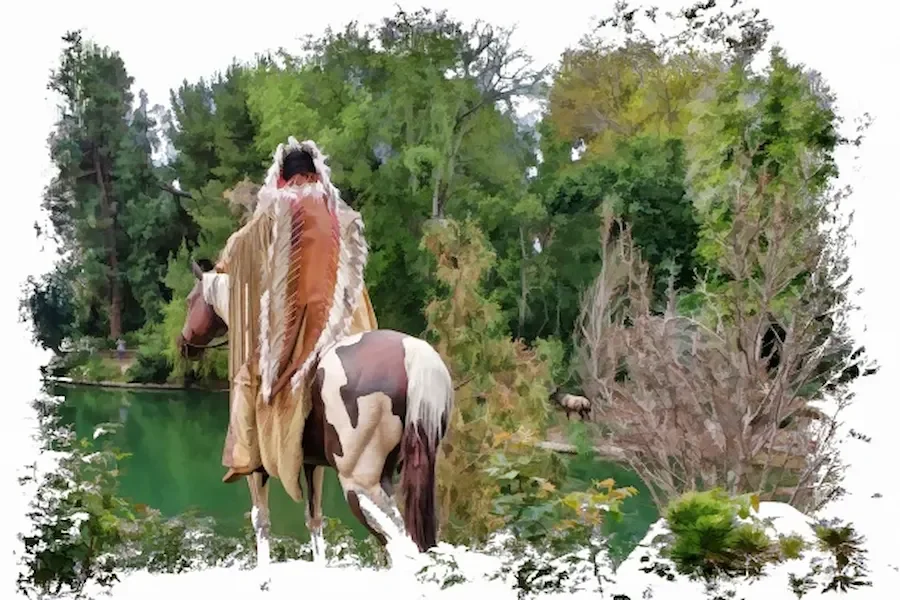Native American art is the visual art of the Americas’ indigenous peoples. Many themes have become a source of inspiration for artists. Among them, the horse has become an icon.
Most current depictions are related to well-known contemporary horses’ racing or the paintings associated with the American west’s historic cowboy or Native American traditions.
Would you like to know more? Learn about the history, function, materials, and symbolism of Native American horse art in the sections below.
History

The origins of most Native American ornamental motifs are unknown today. However, there is evidence that some of the original shapes were the work of individual artists and that they were often the outcome of a vision quest.
The realm of the vision quest is enigmatic to the American Indian, a place where the spirit might leave the body, engage in bizarre activities, and view weird sights.
Many critics insist that many designs or creatures witnessed during the vision quest protect forms or spirit-beings.
Since these supernatural experiences were so personal, they were often documented by the individual, resulting in a wide range of artistic qualities.
Many horse images appear in artwork related to the historic cowboy or Native American heritage of the American West.
Frederic Remington and C.M. Russell are two artists from the American West who became well-known for their paintings of horses.
Along with Thomas Eakins, Remington was one of the first American painters to depict the natural stride in motion, as shown by Eadweard Muybridge’s renowned sequential pictures.
Remington’s bronze sculptures likewise caught equestrian drama; his first, Bronco Buster (Williams College Museum of Art), was critically and commercially successful.
Function

Religious motifs were woven and painted into Native American blankets or clothing to calm enraged gods causing devastation in nature, observe new spirits, and scare away malevolent spirits.
Native American arts usually take on a practical form that reflects the nations’ socioeconomic structure. Weapons, regalia, and armor seem to have been primary art forms in political and military circles.
It may be found in the Plains, Aztec, and Inca civilizations and represents the dominant warrior culture. Religious cultures tended to have more ceremonial art than non-religious ones.
For example, all of the Maya’s creative representations demonstrate the importance of theocracy in their society. www.senpaisquad.net
Not all art, however, was religious or political. Most societies created many ordinary, funny, and even obscene skills.
Even though most of the eroticism has perished in the Puritan flames that continue to burn the Westerner, there are enough instances from ancient and modern periods to suggest relaxed freedom of expression reflecting a healthy, naturalistic lifestyle.
Materials

Native American cultures worked with materials indigenous to their homelands to develop art that reflected their environment.
People who lived in heavily forested places, for example, developed naturally into good wood sculptors; those who had access to clay developed naturally into expert potters; and those who lived in grasslands developed naturally into skilled basket weavers.
The artist used jade, shell, turquoise, metals, milkweed fiber, stone, llama dung, birch bark, deer hair, porcupine quills, and sea lion whiskers to add texture and color to the finished piece.
Such minerals were often sought-after commodities traded across large distances.
In many cases, the materials established a typical economic value and were widely accepted as a means of exchange wherever they were fashionable.
The relationship between material and design in American Indian art differed significantly from Western art.
On the other hand, the sculptor put a shape on the material based on predetermined spatial arrangements.
On the other hand, American Indian painters and sculptors were less likely to force their materials to follow a planned pattern.
Instead, they built around the inherent curves of their materials, which were often a complete and hence uneven buffalo hide, a tree limb, or a stone.
Naturalism is one of the most attractive aspects of American Indian art, and it often demonstrates the artist’s exceptional ability to incorporate natural forms into the design.
The video below describes the process of making a work of Native American art:
Native American Horse Symbolism

The horse was a significant factor in the development of civilization. The artist handled it with excellent care as a sign of dignity and reverence.
Native American horse art has a variety of symbolic meanings, some of which symbolize the horse’s appearance and others on its duties.
It became a symbol of elegance, beauty, and grandeur, for example, because of its intrinsic characteristics. It was also a symbol of strength, power, and liberty.
This animal was also associated with the four elements of earth, air, fire, and water. Various civilizations used the horse as a significant symbol in combat art.
It was an everyday companion of Native warriors on the battlefield. Unique battle shirts were typically embroidered with horsehair of various hues to recognize the role and link between man and horse. This animal was a symbol that linked the force of the land with wisdom.
Many diverse pieces of art proudly depicted the distinguished animal. These people used this animal as a central figure in their paintings and rock art. Various colored horses, on the other hand, had different symbolic significance.
The black horse, which often appears in Native American art, symbolizes secrecy and esoteric wisdom. It is also a symbol of death, darkness, and secrecy.
On the other hand, the white horse represented resurrection, enlightenment, vigor, and brightness.
Native American Horse Paint Symbols
Native American cultures painted symbols on their horses for a variety of purposes. Warfare is the most typical explanation.
Before combat, they painted some signs on the horses to make them quicker, more robust, and braver. American Indians painted symbols on the horses to represent their rider’s victory/defeat.
However, painting their horses wasn’t the only reason they did it. They painted medicine symbols on several horses and hunting symbols on others.
War Horse Symbols
- A circle around the horse’s eye and nose for sharp eyesight and a good sense of smell.
- The arrow points in the direction of triumph.
- They painted the horse’s front legs with thunder stripes to appease the Indian deity of battle.
- The racehorse was speedy and nimble-footed thanks to arrowheads on all four feet.
- Fire Arrows would give the fighter more power.
- The right and left-hand impressions delineated on the horse’s chest indicate that he’d struck down an adversary.
- Hail Stones were a warrior’s prayer for hail to fall on his foe.
- The horse and his rider had evaded ambush thanks to two crossing bars.
- The hoofprints represented the number of horses seized in raids.
- The lengthy zig-zag lines represent lightning, which gives this animal more force and speed.
Horse War Paint Colors
- War, blood, strength, energy, and power were all symbols.
- The color black symbolizes victory.
- White is a symbol of grief, but it might also tell peace.
- The color blue was associated with knowledge and self-assurance.
- The color yellow was associated with death. The color yellow denoted bravery and willingness to fight to the death for the wearer and horse.
- Green rings painted around the eyes symbolize endurance, tremendous healing power, and the ability to increase eyesight.
- Purple is a color that represents strength, mystery, and magic.
Hunting Horse Symbols
- The Circle of Vision painted around the horse’s eye gives him the sharp vision and allows him to be the first to spot the faraway buffalo.
- A Fence sign put on the horse’s mouth assists in retaining good luck.
- The hunter used the Sacred Buffalo sign to convey to the Great Spirit that he was grateful for his previous kills.
- An Arrow of Swiftness painted on the horse’s legs gives him speed.
- The buffalo tracks decorating the horse’s hips indicate previous excellent hunting experiences.
FAQs
How did Native Americans decorate their horses?
They pressed or crushed red and white clays, berries, barks, eggshells, charcoal, plants, flower petals, moss, ashes, root juice, and other materials to form pigment. Each symbol and color has its meaning.
What is Native American art called?
Native American art is the visual art of the Americas’ indigenous peoples.
What Native American tribes had horses?
The aggressive Comanche, who were “perhaps the greatest horse Indians on the Plains,” according to Viola, were among the Plains Indians’ “Horse Nation” during its peak, along with the Cheyenne, Arapaho, Lakota (Sioux), Crow, Gros Vent Nez Perce, and others.
What are native American horses called?
According to its breed registration, the American Indian Horse is a horse with heritage from the Spanish Barb, Arabian, Mustang, or “Foundation” Appaloosa.
It is a descendent of horses introduced to the Americas by the Spanish and afterward acquired by Native Americans.
Why did natives paint their horses?
Indians painted their horses for combat and decorated them before buffalo hunts. Hunting symbols show off a horse’s previous accomplishments and offer protection and good luck to both the horse and the rider.
Suggested For You >> Find the best gift for Mom
Summary
Native American horse art has little significance in the modern art scene. Until recently, you can find the only serious attempt to show this work in galleries or museums dedicated only to American Indian materials.
Many young people are becoming more interested in American Indian cultural expression. They desire to learn about history and preserve what they can. If you’re one of them, you would love our compiled list of 22 fantastic native American gift ideas!
Hopefully, you have gained valuable knowledge. If you love this art form, leave a comment. Geembi will recommend some striking modern pieces of artwork that may add spark to your home.

